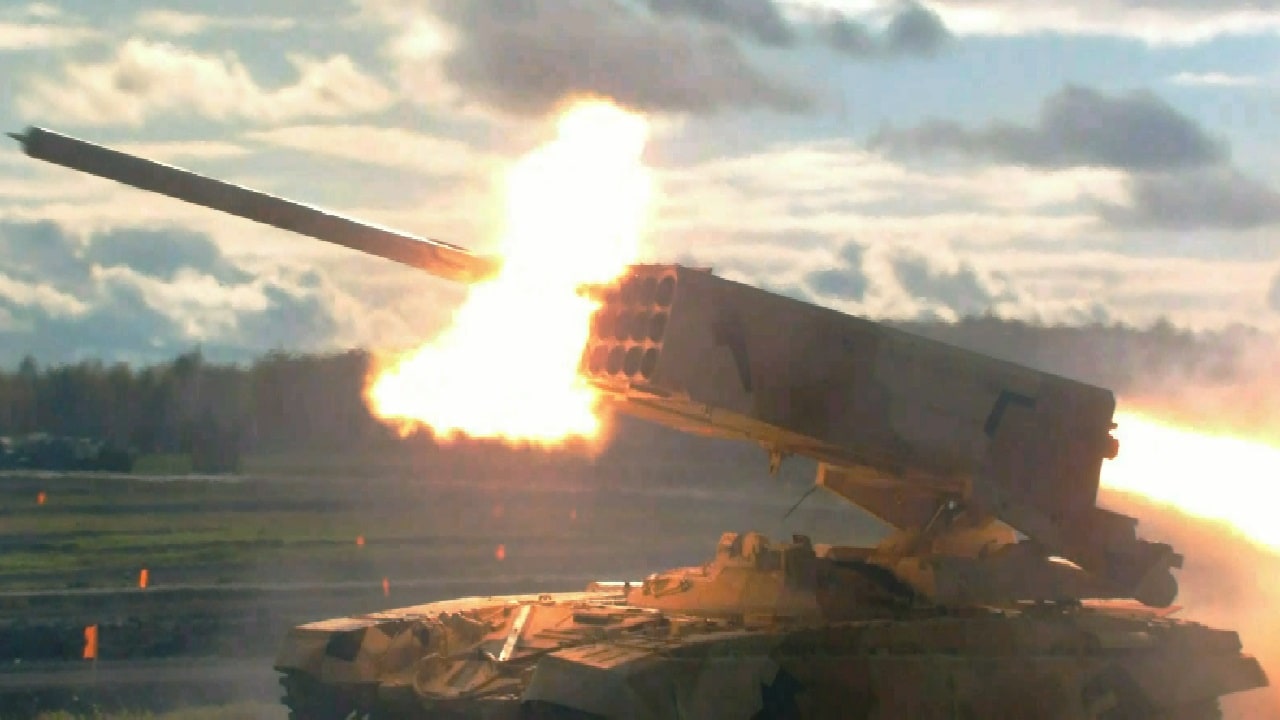Footage from a video shared on social media on Thursday evening could have been mistaken for a victory celebration in the city of Bakhmut.
What appeared to be fireworks that rained down over the city were, in fact, actually 9M22S Thermite rockets deployed by Russian MLRS. As the post to Twitter noted, these had the potential to burn everything on the ground.
This is also not the first time videos of the incendiary rockets have been shared online. Though it may look almost spectacular in the night sky, it would likely be a terrifying sight for those on the ground.
Last year, Euan MacDonald (@Euan_MacDonald), editor-at-large for the New Voice of Ukraine, was quick to note that “Thermite burns at 3,000 C – through metal. Ukraine’s troops are facing some of the most savage, barbarous weapons ever devised.”
It should be further added that 3,000 degrees Celsius is 5,432 degrees Fahrenheit, nearly twice the temperature at which iron melts.
There have been several documented cases of the use of the Soviet-designed 9M22S incendiary rockets being deployed in Ukraine. As early as March 2022, the insidious weapons were fired near the town of Popasna, Luhansk Oblast, in eastern Ukraine. The rockets were then fired again in April 2022 at the village of Novoiakovlivka, near the city of Zaporizhzhia in south-eastern Ukraine – likely launched by a 9K51 Grad or upgraded 9K51M Tornado-G multiple-barrel rocket launcher (MBRL).
The rockets were also reportedly among the weapons used during Russia’s assault on the Azov Steel Plant in Mariupol to break the month-long siege last spring.
Rain of Fire
The 9M22S 122 mm incendiary rocket was developed by the Splav State Research and Production Association in 1971. It was based on the 9M22 high explosive fragmentation (HE-FRAG) munition, but in place of the HE-FRAG warhead, it was designed to carry the 9N510 warhead, which contains 180 individual incendiary elements. The un-fuzed incendiary elements are ignited on ejection by an ignition/expelling charge of six linear-shaped charges (LSC).
The elements include ML-5 magnesium cups filled with a thermite-type mixture and packed in a matrix, each element having a burning time of at least two minutes.
Though some photos of the 9M22S posted online suggest it contains phosphorus, this is actually not the case. However, the rockets are just as destructive.
The weapon was designed to be deployed against enemy personnel and flammable targets. Cold War-era Soviet manuals for the 9M22S specifically detail the intended use of the weapon in areas of dry vegetation. However, the Kremlin has employed the munitions in areas primarily or exclusively containing civilians and civilian objects.
Footage from #Bakhmut, where fierce fighting is still going on.
9M22S Thermite rockets deployed by Russian MLRS over the city, burning things…everything. pic.twitter.com/N48jH6AXtz
— M|§F|T (@misfit_4) April 13, 2023
Human Rights Watch has described incendiary weapons as being “among the cruelest weapons used in contemporary armed conflict. These weapons, which produce heat and fire through the chemical reaction of a flammable substance, cause immediate and lifelong human suffering in addition to destroying homes and other civilian structures.”
Author Experience and Expertise
A Senior Editor for 19FortyFive, Peter Suciu is a Michigan-based writer. He has contributed to more than four dozen magazines, newspapers, and websites with over 3,200 published pieces over a twenty-year career in journalism. He regularly writes about military hardware, firearms history, cybersecurity, politics, and international affairs. Peter is also a Contributing Writer for Forbes and Clearance Jobs. You can follow him on Twitter: @PeterSuciu.

